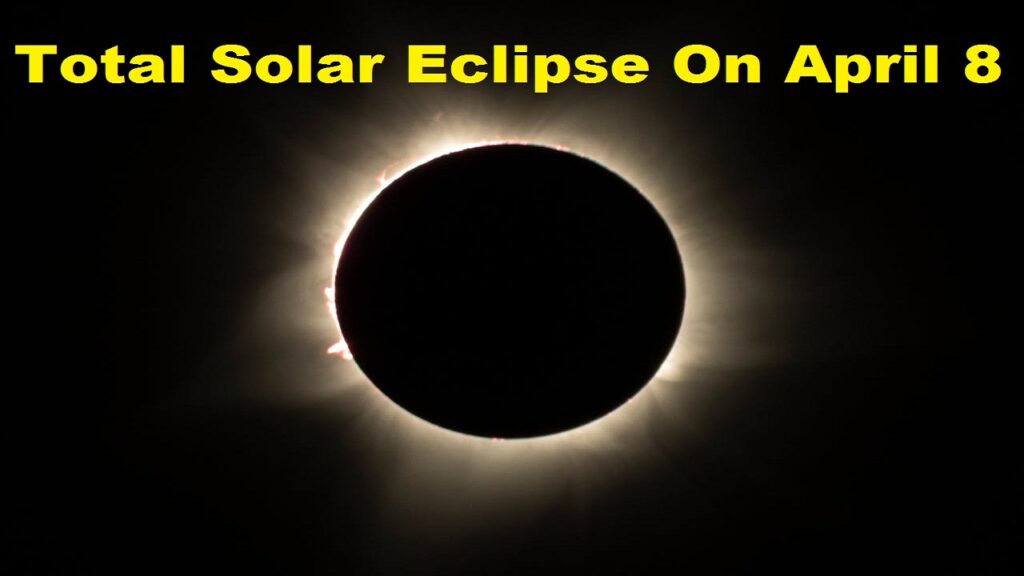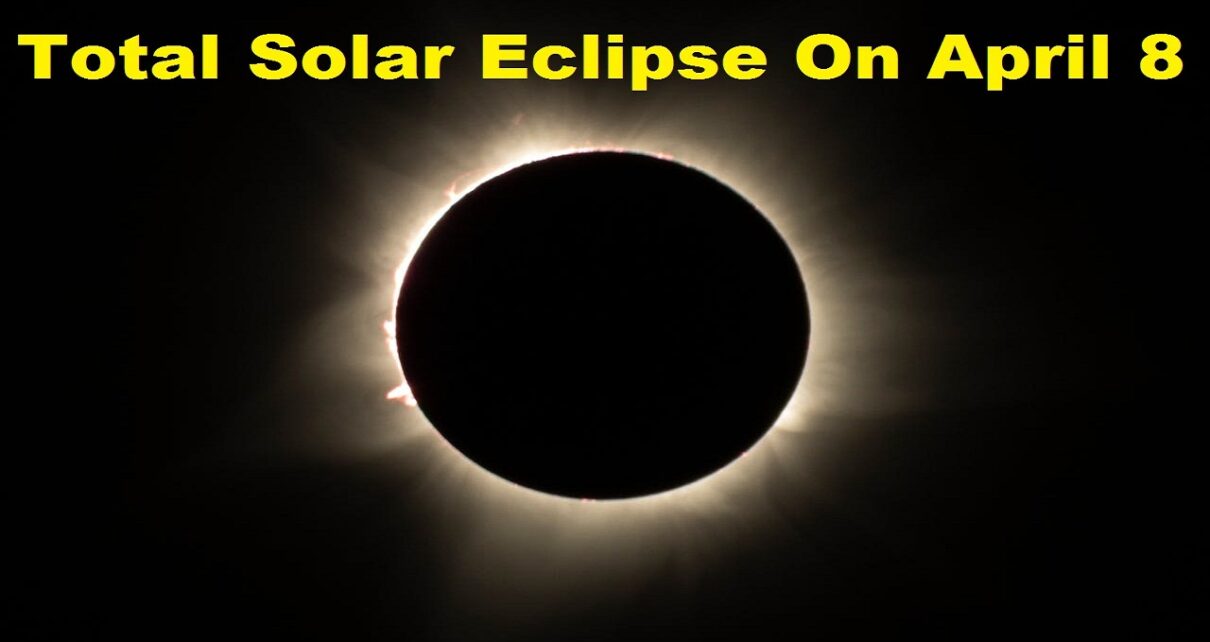
Total Solar Eclipse On April 8 : Get ready for a celestial spectacle! On April 8th, 2024, a total solar eclipse will grace the skies across North America, transforming day into a dusky twilight for a brief but awe-inspiring moment. This rare event, where the Moon completely blocks the Sun’s light, is a chance to witness the intricate dance between our celestial neighbors. But before the magic unfolds, let’s delve into the science behind this phenomenon, explore its visibility, and discover safe ways to witness it, even if you’re outside the path of totality.
Total Solar Eclipse On April 8
Unveiling the Mystery: The Science of a Solar Eclipse
A solar eclipse occurs when the Moon aligns perfectly between the Earth and the Sun, casting a shadow on a specific region of our planet. This shadow consists of two parts: the umbra, where the Moon completely blocks the Sun’s light, and the penumbra, where the Sun is only partially obscured. The narrow band on Earth’s surface that experiences the complete blockage of sunlight is called the “path of totality.” Here, the sky darkens dramatically, revealing the faint glow of the Sun’s corona, its outermost atmosphere, and even some stars.
While a total eclipse is the most dramatic, a partial eclipse can also be observed from a wider region. Here, the Moon covers only a portion of the Sun, creating a crescent-shaped silhouette. The degree of darkness and the visible portion of the Sun will vary depending on your location relative to the path of totality.
Mapping the Eclipse: When and Where to Look Up
The 2024 total solar eclipse will be visible across a 185-kilometer-wide path stretching from Mexico, through the United States, and into Canada. Skywatchers in as many as 18 US states will have the opportunity to witness this celestial event firsthand. However, for those in India, this eclipse won’t be directly observable due to the geographical location.
Here’s a breakdown of the timings for the eclipse (in Indian Standard Time):
- Start: April 8, 2024, at 9:12 PM IST
- Totality: April 8, 2024, at 10:08 PM IST (This is the phase where the Moon completely covers the Sun)
- End: April 9, 2024, at 2:22 AM IST
The path of totality will touch the Pacific coast of Mexico first, with totality beginning around 11:07 AM PDT. It will then traverse through various US states before exiting North America at around 1:30 PM PDT from Maine.
A Fleeting Spectacle: The Duration of the Eclipse
The entire eclipse event can last for approximately two and a half hours. However, the most captivating moment – totality – is a fleeting phenomenon, lasting only about four minutes. NASA predicts the peak of the eclipse will offer up to 4 minutes and 27 seconds of complete darkness within the path of totality. Locations along the centerline will experience totality for a duration between 3.5 and 4 minutes.
Safety First: Protecting Your Eyes During the Eclipse
It’s crucial to remember that the Sun’s surface is incredibly bright. Looking directly at the Sun, even during a partial eclipse, can cause permanent eye damage or even blindness. Here’s how to protect your eyes during the eclipse:
Use specially designed eclipse glasses: Invest in eclipse glasses that meet the ISO 12312-2 international safety standard. These glasses have special filters that block harmful solar radiation, allowing you to safely view the eclipse without damaging your eyes.
Never look directly at the Sun: Even during a partial eclipse, avoid looking directly at the Sun without proper eye protection.
Seek professional guidance: If you’re unsure about safe viewing methods, consult with an astronomer or a reputable scientific organization.
Experiencing the Eclipse Virtually: Live Streaming Options
If you’re outside the path of totality or can’t witness the eclipse firsthand, fret not! Several organizations will be hosting live streams of the event, allowing you to experience this astronomical marvel virtually. Here are a few options:
NASA: Witness the eclipse from the perspective of NASA. Their live stream will begin at 5:00 PM GMT (10:30 PM IST) on April 8th and continue until 8:00 PM GMT (1:30 AM IST) on April 9th. The broadcast will feature expert commentary and telescope views from various locations along the path of totality.
McDonald Observatory, Texas: This renowned observatory will also be offering a live stream of the eclipse.
Time and Date Website: The popular skywatching website timeanddate.com is joining the party, hosting its own live stream of the eclipse on its YouTube channel. This stream starts at 4:30 PM GMT (10:00 PM IST) on April 8th, ensuring you don’t miss a single moment of the celestial drama.
Capturing the Moment: Tips for Photographing the Eclipse
If you’re fortunate enough to witness the eclipse in person and possess a camera, here are some tips for capturing this celestial phenomenon:
- Invest in a sturdy tripod: A stable tripod is essential for capturing sharp images during the eclipse, especially during totality when light levels will be significantly reduced.
- Use a neutral density filter: A neutral density filter helps to reduce the amount of light entering your camera sensor, allowing you to capture longer exposures without overexposing the image. This is particularly useful for capturing details in the Sun’s corona.
- Experiment with different shutter speeds and apertures: The ideal settings will depend on the phase of the eclipse. During totality, you can use longer shutter speeds to capture details in the corona. During the partial phases, you may need to adjust your shutter speed and aperture to achieve the desired exposure.
- Focus on manual mode: Switch your camera to manual mode to control shutter speed, aperture, and ISO independently.
- Consult with experienced astrophotographers: Seek guidance from astrophotography enthusiasts or online resources for more detailed tips and techniques for capturing the eclipse.
By following these tips and using the right equipment, you can capture stunning images of the eclipse, preserving this celestial event for years to come.
A Final Word: Awe and Inspiration from the Cosmos
The total solar eclipse of April 8th promises to be an unforgettable event for those lucky enough to witness it. Whether you’re gazing upwards from the path of totality or joining the virtual audience, this celestial spectacle offers a glimpse into the remarkable dance of our solar system. Let this eclipse inspire a sense of awe and wonder at the vastness of the universe and the intricate celestial mechanics that govern our world. Remember, this fleeting event is a testament to the delicate balance that sustains life on Earth, and a reminder of the ongoing scientific quest to unravel the mysteries of our cosmic neighborhood.
- Unleash the Harvest: Fast-Growing Vegetables for California’s Raised Garden Beds
 Fast-Growing Vegetables for California’s Raised Garden Beds : California’s golden sunshine, mild climate, and fertile soil are a gardener’s dream. Elevated planting in raised garden beds takes this advantage to the next level. These controlled environments offer improved drainage, easier pest management, and the perfect canvas for cultivating a fast and furious vegetable bounty. Fast-Growing… Read more: Unleash the Harvest: Fast-Growing Vegetables for California’s Raised Garden Beds
Fast-Growing Vegetables for California’s Raised Garden Beds : California’s golden sunshine, mild climate, and fertile soil are a gardener’s dream. Elevated planting in raised garden beds takes this advantage to the next level. These controlled environments offer improved drainage, easier pest management, and the perfect canvas for cultivating a fast and furious vegetable bounty. Fast-Growing… Read more: Unleash the Harvest: Fast-Growing Vegetables for California’s Raised Garden Beds - Pitbull Announces Party After Dark Tour With T-Pain: A Must-See Event for Music Lovers
 Pitbull Announces Party After Dark Tour With T-Pain : Pitbull, the renowned artist known for his electrifying performances and chart-topping hits, has recently announced the much-anticipated “Party After Dark Tour” featuring none other than the iconic T-Pain as a special guest. This tour promises to be a spectacular celebration of music, bringing together two powerhouse… Read more: Pitbull Announces Party After Dark Tour With T-Pain: A Must-See Event for Music Lovers
Pitbull Announces Party After Dark Tour With T-Pain : Pitbull, the renowned artist known for his electrifying performances and chart-topping hits, has recently announced the much-anticipated “Party After Dark Tour” featuring none other than the iconic T-Pain as a special guest. This tour promises to be a spectacular celebration of music, bringing together two powerhouse… Read more: Pitbull Announces Party After Dark Tour With T-Pain: A Must-See Event for Music Lovers - Unwind with Your Furry Friend: Pet-Friendly Cabins with Private Hot Tubs near Yellowstone National Park
 Pet-Friendly Cabins with Private Hot Tubs near Yellowstone National Park : Yellowstone National Park, a crown jewel of the American wilderness, beckons adventurers with its geysers, hot springs, and breathtaking landscapes. But what if you could experience this wonder alongside your furry best friend? Imagine returning from a day of exploring the park’s marvels, sharing… Read more: Unwind with Your Furry Friend: Pet-Friendly Cabins with Private Hot Tubs near Yellowstone National Park
Pet-Friendly Cabins with Private Hot Tubs near Yellowstone National Park : Yellowstone National Park, a crown jewel of the American wilderness, beckons adventurers with its geysers, hot springs, and breathtaking landscapes. But what if you could experience this wonder alongside your furry best friend? Imagine returning from a day of exploring the park’s marvels, sharing… Read more: Unwind with Your Furry Friend: Pet-Friendly Cabins with Private Hot Tubs near Yellowstone National Park - Cultivate Your Dreams: Building a Raised Garden Bed in Tight Spaces
 Building a Raised Garden Bed in Tight Spaces : For city dwellers and space-conscious gardeners, the dream of fresh, homegrown produce might seem like a distant utopia. But fret no more! Raised garden beds offer a game-changing solution, transforming even the most limited balconies, patios, or sunny nooks into flourishing mini-farms. Building a Raised Garden… Read more: Cultivate Your Dreams: Building a Raised Garden Bed in Tight Spaces
Building a Raised Garden Bed in Tight Spaces : For city dwellers and space-conscious gardeners, the dream of fresh, homegrown produce might seem like a distant utopia. But fret no more! Raised garden beds offer a game-changing solution, transforming even the most limited balconies, patios, or sunny nooks into flourishing mini-farms. Building a Raised Garden… Read more: Cultivate Your Dreams: Building a Raised Garden Bed in Tight Spaces - Best Organic Mattresses for Back Pain Sufferers Under $1,500
 Best Organic Mattresses for Back Pain Sufferers Under $1,500 : Waking up with a crick in your neck or lower back pain can put a damper on anyone’s day. But for chronic back pain sufferers, a good night’s sleep can feel like a distant dream. The right mattress can make a world of difference, providing… Read more: Best Organic Mattresses for Back Pain Sufferers Under $1,500
Best Organic Mattresses for Back Pain Sufferers Under $1,500 : Waking up with a crick in your neck or lower back pain can put a damper on anyone’s day. But for chronic back pain sufferers, a good night’s sleep can feel like a distant dream. The right mattress can make a world of difference, providing… Read more: Best Organic Mattresses for Back Pain Sufferers Under $1,500




